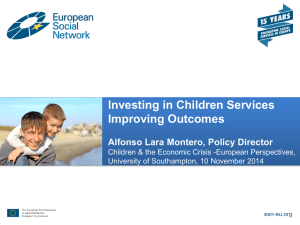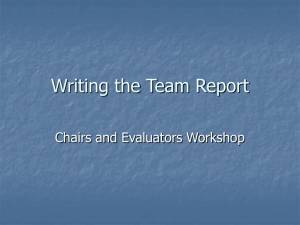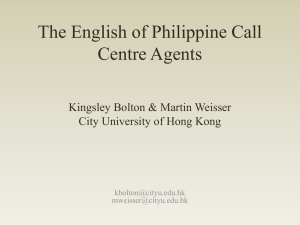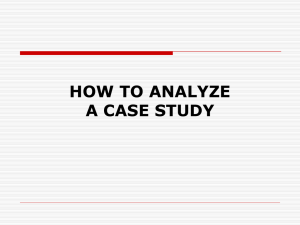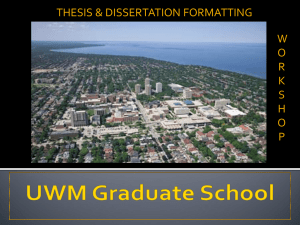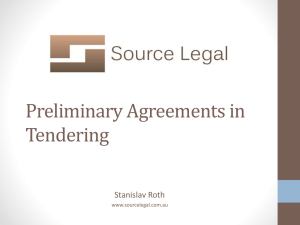Content and Formatting Instructions
advertisement
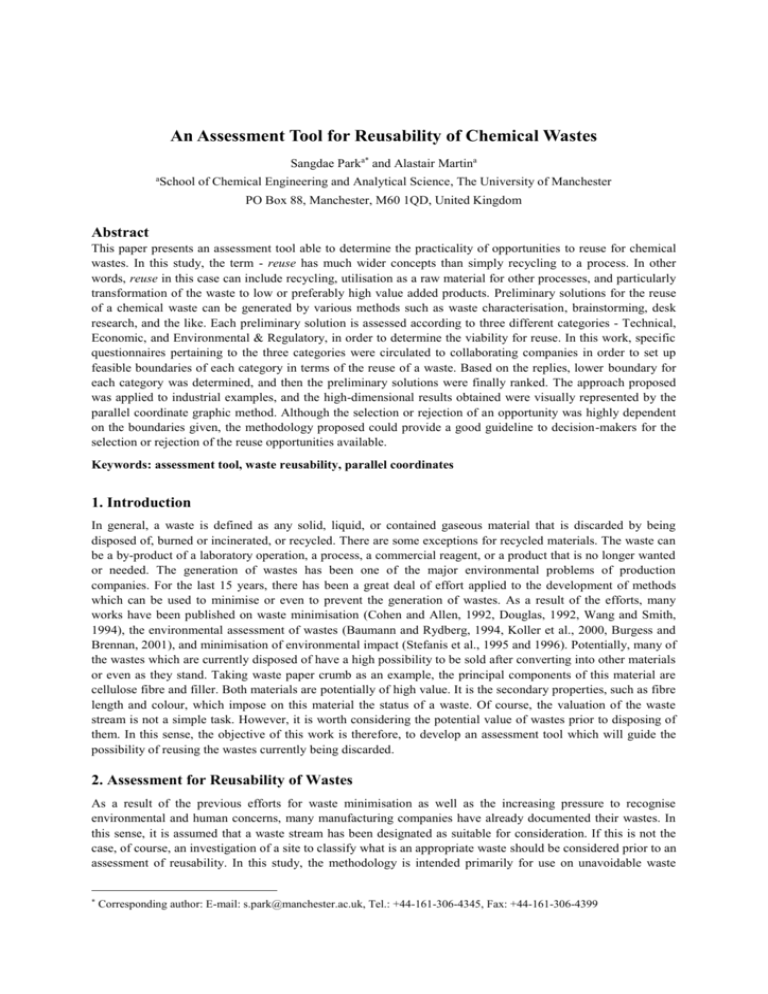
An Assessment Tool for Reusability of Chemical Wastes
Sangdae Parka* and Alastair Martina
a
School of Chemical Engineering and Analytical Science, The University of Manchester
PO Box 88, Manchester, M60 1QD, United Kingdom
Abstract
This paper presents an assessment tool able to determine the practicality of opportunities to reuse for chemical
wastes. In this study, the term - reuse has much wider concepts than simply recycling to a process. In other
words, reuse in this case can include recycling, utilisation as a raw material for other processes, and particularly
transformation of the waste to low or preferably high value added products. Preliminary solutions for the reuse
of a chemical waste can be generated by various methods such as waste characterisation, brainstorming, desk
research, and the like. Each preliminary solution is assessed according to three different categories - Technical,
Economic, and Environmental & Regulatory, in order to determine the viability for reuse. In this work, specific
questionnaires pertaining to the three categories were circulated to collaborating companies in order to set up
feasible boundaries of each category in terms of the reuse of a waste. Based on the replies, lower boundary for
each category was determined, and then the preliminary solutions were finally ranked. The approach proposed
was applied to industrial examples, and the high-dimensional results obtained were visually represented by the
parallel coordinate graphic method. Although the selection or rejection of an opportunity was highly dependent
on the boundaries given, the methodology proposed could provide a good guideline to decision-makers for the
selection or rejection of the reuse opportunities available.
Keywords: assessment tool, waste reusability, parallel coordinates
1. Introduction
In general, a waste is defined as any solid, liquid, or contained gaseous material that is discarded by being
disposed of, burned or incinerated, or recycled. There are some exceptions for recycled materials. The waste can
be a by-product of a laboratory operation, a process, a commercial reagent, or a product that is no longer wanted
or needed. The generation of wastes has been one of the major environmental problems of production
companies. For the last 15 years, there has been a great deal of effort applied to the development of methods
which can be used to minimise or even to prevent the generation of wastes. As a result of the efforts, many
works have been published on waste minimisation (Cohen and Allen, 1992, Douglas, 1992, Wang and Smith,
1994), the environmental assessment of wastes (Baumann and Rydberg, 1994, Koller et al., 2000, Burgess and
Brennan, 2001), and minimisation of environmental impact (Stefanis et al., 1995 and 1996). Potentially, many of
the wastes which are currently disposed of have a high possibility to be sold after converting into other materials
or even as they stand. Taking waste paper crumb as an example, the principal components of this material are
cellulose fibre and filler. Both materials are potentially of high value. It is the secondary properties, such as fibre
length and colour, which impose on this material the status of a waste. Of course, the valuation of the waste
stream is not a simple task. However, it is worth considering the potential value of wastes prior to disposing of
them. In this sense, the objective of this work is therefore, to develop an assessment tool which will guide the
possibility of reusing the wastes currently being discarded.
2. Assessment for Reusability of Wastes
As a result of the previous efforts for waste minimisation as well as the increasing pressure to recognise
environmental and human concerns, many manufacturing companies have already documented their wastes. In
this sense, it is assumed that a waste stream has been designated as suitable for consideration. If this is not the
case, of course, an investigation of a site to classify what is an appropriate waste should be considered prior to an
assessment of reusability. In this study, the methodology is intended primarily for use on unavoidable waste
*
Corresponding author: E-mail: s.park@manchester.ac.uk, Tel.: +44-161-306-4345, Fax: +44-161-306-4399
streams which will be high-priority waste streams from the viewpoint of the company. When the waste streams
have been identified as suitable for consideration the data gathering can begin.
2.1 Characterisation of Waste
Each designated waste stream will be thoroughly but efficiently characterised in order to provide vital
information concerning the material to be used during the ideas generation stage. This will involve work to be
conducted on-site and with representative samples of the waste material, as well as work conducted off-site,
including gathering information from a variety of sources to build a portfolio of relevant worldwide best practice
in the field of waste utilization. The following works can be carried out with the collaborating company; (i)
Investigation for process history of the waste and the overall operation of the site. It may include a relatively
simple block process flow diagram just showing the main plant items, the flow of materials and the origin of the
waste where in the process it arose. (ii) Time spent on a site visit to observe the operation. This time can also be
spent obtaining samples to be taken away for testing as necessary. Of course, samples should be taken according
to established protocols. It could be worthwhile sampling waste streams as close to the point of origin as
possible, particularly where individual waste streams are later mixed to produce a single composite stream for
disposal. In summary, the information which can be obtained from on-site work will be the quantity of waste
being produced, the current destination of the waste streams, the true cost of disposing of the waste, regulations
covering the treatment or use of the waste streams, and any other existing facts the company has already
examined in terms of the waste streams. On the other hand, a significant part of the off-site work will involve
building up knowledge of the physical characteristics of the waste material and that could involve timeconsuming work in the laboratory. It is up to the data gatherer to decide what physical characteristics of the
waste material are important at this stage of the investigation. As a guideline, the data gathering here is intended
to eventually provide information that will be valuable during ideas generation stage. It is important not to spend
too much time in the laboratory obtaining information that does not add significantly to the data gathered from
the site visits and communication with the company. However, if the waste material from a company is relatively
unknown some work will be inevitable since some basic information concerning the waste such as the
appearance, composition, etc. needs to be known prior to ideas generation stage. The other major part of off-site
work will involve investigating work that has been performed world-wide concerning the possibility of further
uses for the waste stream, for example, works carried out on any material that shares characteristics similar to
those of the waste material. Subsequently, the salient information gathered from on- and off-site works will be
assembled into a concise briefing document suitable to be circulated amongst any parties involved in the project.
As well as the hard facts this document provides a history of the waste material enabling rapid appreciation of
the material and its origins from a point of zero knowledge.
2.2 Generation of Ideas
At this stage information gathered from a diverse range of sources will be combined to form an encompassing
base of knowledge comprising a multitude of preliminary solutions for utilizing the waste material. A
preliminary solution is one whose advantages and disadvantages have not been established in detail, but is
identified as worthy of investigation. All the preliminary solutions will be gathered from a number of sources
including desk research, consultation with industrial and academic contacts, conferences and workshops or
brainstorming sessions. As a result, various preliminary solutions will be generated and these ideas will be taken
forward to the next stage, i.e. Assessment for the reusability.
2.3 Assessment for Reusability
The objective of this stage is to select the most promising preliminary solutions without expending undue
resources. A large number of preliminary solutions may be generated in the previous stage and it would be
unwieldy and inefficient to consider all the ideas in detail. Each preliminary solution will be analysed
individually using a number of criteria, broadly divided into three categories; technical, economic and
environmental and regulatory. In addition, variability factors for the criteria are also considered to reflect the
possibilities of the changes for the criteria. All of these criteria are subjected to a brief but well-informed analysis
to give a first best estimate and the results combined in a process known as a multi-criteria scoring system. A
multi-criteria scoring system provides a method to evaluate the overall merit of a solution on the basis of a
number of potentially conflicting and diverse criteria constrained by lower boundaries of acceptability by
measuring the scores according to a set of criteria in standardised units and combining scores using simple
mathematical techniques. This involves drawing up a unique profile for each preliminary solution illustrating its
strengths and weaknesses.
Technical score for a preliminary solution k ( Technical ): It reflects how well-established the technology
k
required by the preliminary solution is, the amount of research that has been conducted into the
preliminary solution and how much more will be needed, any reliance on seasonal demand for a product,
whether the preliminary solution provides a safe final destination for the waste material for which no
further attention is due, and whether the preliminary solution can provide a single destination for the
entirety of the waste material.
Economic score for a preliminary solution k ( Economic ): It is given after first estimates of capital cost,
k
operating cost and profit margins. It may also reflect saleability or marketability for the solution.
Environmental and regulatory score for a preliminary solution k ( Environ&regulatory): It is measured after
k
considering the flexibility of the location of any new operations required by the realisation of the
preliminary solution, the possibility of creating new job opportunities by expanding operations, judging
whether public concern is likely to arise due to the preliminary solution being implemented, whether any
discharges needing attention will result from the preliminary solution, whether the solution will require
the construction of large structures, the permits required to implement the preliminary solution and the
likelihood of future regulations impacting on the continuation of the solution. In this study, all scores of
the three criteria for each preliminary solution have been estimated as a result of consultation with
industrial and academic contacts.
Table 1. Company priority questionnaire
Statements
Please circle a number from 1 to 5 indicating how much you agree
with the following statements (5 being to agree the most strongly)
Q1. We would prefer to find technology that has been wellestablished for a significant period.
Q2. We would be interested in involving a continuous process
rather than a batch process.
Q3. We are willing to invest significant time and money
researching an alternative destination for our waste.
Q4. It is a priority for us to find an alternative destination for our
waste that will not involve investing significant capital.
Q5. It is a priority for us to find an alternative destination for our
waste that will not involve high operating costs.
Q6. It is a priority for us to find an alternative destination for our
waste that gives a high financial return.
Q7. We are interested in an alternative destination for our waste
that creates a positive social impact in an area.
Q8. We would take strenuous measures to ensure that few harmful
emissions are resulted in.
Q9. We would prefer to find an alternative destination for our
waste that will not involve having to apply for any permits.
Strongly
disagree
Strongly
agree
1
2
3
4
5
1
2
3
4
5
1
2
3
4
5
1
2
3
4
5
1
2
3
4
5
1
2
3
4
5
1
2
3
4
5
1
2
3
4
5
1
2
3
4
5
Lower boundary of acceptability of each criterion i (LBi): These reflect the minimum levels of concern
regarding the three criteria (Technical, Economic and Environmental & regulatory) in the company. In
this study, in particular, questionnaires were circulated to the company in order to find out indirectly what
level of concern for each criterion the company has. However, it is possible to do this directly by asking
the company regarding to the minimum levels for the criteria. The questionnaire circulated is shown in
Table 1. In the table, first three questions (Q1 to Q3) are utilised to estimate the lower boundary for
technical criterion of the company, next three questions (Q4 to Q6) are used for measuring the lower
boundary of economic criterion, the lower boundary for environmental and regulatory one is estimated by
using the remaining questions (Q7 to Q9). It is worth noting that the number of questions needs to be
extended in order to observe the company’s concern more accurately. In this study, the average value of
the scores obtained from questionnaire was simply used. In other words, the lower boundary for each
criterion (LBi) can be written as follows.
LBi
S
jQi
| Qi |
j
, iI = {Technical, Economic, Environ & regulatory}
(1)
In Equation (1), Sj denotes the score marked for the question j, and subset Qi indicates the questions
related to the criterion i, whereas |Qi| means the number of questions included in the subset. Based on the
questionnaire shown in Table 1 above, the subset QTechnical = {Q1, Q2, Q3}, QEconomic = {Q4, Q5, Q6} and
QEnviron&regulatory = {Q7, Q8, Q9}. In this case, the number of questions for each criterion are equal to 3, i.e.
|Qi|=3. As a result, the lower boundaries of each criterion can be determined as LBTechnical =
(SQ1+SQ2+SQ3)/3, LBEconomic = (SQ4+SQ5+SQ6)/3 and LBEnviron&regulatory = (SQ7+SQ8+SQ9)/3.
Graphical interpretation: The concept of the assessment of reusability addressed above can be readily
illustrated by a graphical representation called parallel coordinates, where a point in m-dimensional space
is mapped onto a point in 2-dimensional space. Figure 1 shows an example of parallel coordinates
approaches where 5 different preliminary solutions obtained from ideas generation stage were mapped in
2-dimensional space. The lower boundaries obtained from the questionnaire are also shown. It shows both
desirable and undesirable areas, which are separated from the lower bounds of each criterion. It can be
seen that only Solution 1 met company’s criteria since all scores for the criteria are greater than their
lower bounds. Thus Solution 1 will be the most favourable solution. Although the graphical
representation has an advantage for making those easier to understand, it is not straightforward to
determine the prioritisation for the remaining solutions. This disadvantage can be overcome by obtaining
a single total score for each preliminary solution. The details for measuring the total score will be
addressed in the following sections.
: Solution 4
: Solution 5
: Solution 1
: Solution 2
: Solution 3
Scores
5
Desirable
area
4
3
Lower
bounds
2
1
Undesirable
area
0
Technical
Economic
Environmental
& regulatory
Criteria
Figure 1. An example of parallel coordinates approaches
k
Variability factors of each criterion i ( wi ): These reflect the possibility of changes in the near future for
the given scores. Suppose that the preliminary solution generated is manufacturing of biofuel from
vegetable oils. It may receive lower scores for technical and economic criteria but a high score for
environmental and regulatory. However, the score for technical criterion is likely to move into the area of
high score soon, since currently research and development are ongoing and many practical
demonstrations have been reported. In this case, a technical score with a variability factor will be more
realistic and reasonable than one without a variability factor. As another reason, the scores obtained may
need correction parameters to allow for uncertainty caused by the rapid estimation of the scores. All of
the criteria have been analysed in a relatively imprecise and superficial way. In this study, variability
factors are given between -1 and 1, i.e.-1 wik 1. As a result, the preliminary solutions will be
differentiated depending on the variability factors given even though they have the similar reusability in
the beginning. In the same was as determining the scores for the criteria, variability factors have been
estimated by industrial and academic contacts.
Multi-criteria scoring system: In this stage, integration between individual scores and the corresponding
variability factors is performed, as shown in Equation (2). Finally, each preliminary solution has one
value as a total score and it is possible for all the preliminary solutions to be compared and discriminated
between.
TS k (1 wik ) ik , k, I = {Technical, Economic, Environ & regulatory}
(2)
iI
In Equation (2), TSk means total score of the preliminary solution k, wik is the variability factor of the
criterion i for the preliminary solution k, and δik indicates the estimated score of the criterion i for the
solution k. After estimation of total scores for all preliminary solutions by using Equation (2), it will be
possible to determine the most favourable solution (MFS) by Equation (3).
MFS max{ TS k }
(3)
k
Consequently, the profiles for all the preliminary solutions are compared as shown in Figure 2 and the most
favourable solution (MFS) selected as potential use. The remaining preliminary solutions, however, will be
retained as reserved use, for possible consideration in the future.
A List of Preliminary Solutions
Economic Score
Technical Score
Environmental &
Regulatory Score
Multi-criteria
Scoring System
Lower bounds &
Variability factors
Reserved Uses
Potential Uses
Figure 2. A schematic diagram for multi-criteria scoring system
3. Case Study
This example describes the application of the method developed above to a waste stream produced by a
manufacturer of fine chemicals. As a designated waste stream, the company produces 4,000 tonnes of the waste
every year that is sent to landfill at a cost of £80 per tonne, resulting in a total disposal cost of £320k per year.
After investigating the waste stream, it was identified that the waste consists of a combination of impurities
together with two of the main products of the company. The impurities formed about 10 wt% of the wastes. If
the impurities are eliminated, the remaining components of the waste stream can either be utilised as a raw
material for producing other products or recycled to the existing plant. In this stage, all characteristics of the
impurities were identified by simple laboratory chemical and physical analyses. An extensive survey of
literature, consulting experts and holding a brainstorming session that involved the main parties generated a list
of 8 preliminary solutions that could be applied. During this stage, additionally, it was estimated that the possible
value of the material in the waste is a minimum £360k per year if it could be processed suitably. The assessment
of the 8 preliminary solutions was carried out according to the method described above in order to identify the
most suitable potential use of the waste. First of all, a questionnaire was sent to the company in order to
understand and prioritise the concerns of the company regarding to the three categories (Technical, Economic
and Environmental & Regulatory). As a result, the lower bounds for technical, economic, and environmental and
regulatory were estimated as 4.14, 3.33 and 3.92, respectively. During the period, scores and variability factors
of three criteria for all preliminary solutions have been estimated by academic and industrial contacts. Table 2
shows the scores and variability factors for the 8 preliminary solutions, while all preliminary solutions were
mapped in a parallel coordinate graph as shown in Figure 3. In the graph, both scores with and without
variability factors for each preliminary solution were also illustrated, i.e. the highlighted circles with numbers are
the scores with variability factors. As a result of the assessment, preliminary solution 8 was chosen as the
potential use, while the solutions 4 and 7 were held in reserve for future investigation.
Table 2. Scores and variability factors for the preliminary solutions estimated
Preliminary
solutions (k)
1
2
3
4
5
6
7
8
Technical
criterion
Economic
criterion
Environmental &
regulatory criterion
δk
wk
δk
wk
δk
wk
1.0
2.0
4.0
4.5
3.0
4.0
2.8
3.5
0.3
0.3
0.3
0.3
0.3
0.3
0.3
0.3
4.0
3.9
2.0
2.0
2.5
1.0
4.5
5.0
0.1
0.1
0.1
0.1
0.1
0.1
0.1
0.1
4.0
4.0
4.0
4.0
4.0
4.0
4.0
4.0
0.0
0.0
0.0
0.0
0.0
0.0
0.0
0.0
TSk
9.70
10.89
11.40
12.05
10.65
10.30
12.59
14.05
Scores
6
4
3
5
8
4
4
8
6
6
3
8
3
5
7
2
8
7
5
1
2
7
1
2
7
2
Lower
bounds
5
2
5
4
3
4
3
Score without factors
1
1
1
6
0
Technical
Score with factors
6
Economic
Environmental
& regulatory
Criteria
Figure 3. Graphical analysis by the parallel coordinate graph
4. Conclusions and Discussion
In this study, a systematic approach to assess the reusability for chemical wastes was proposed. As described in
the earlier sections, various preliminary solutions for the reuse of a waste could be obtained through
brainstorming, desk research and workshops or conferences. For the preliminary solutions generated, three
criteria, i.e. technical, economic, environmental & regulatory were considered in order to identify advantages
and disadvantages of each preliminary solution more efficiently. On the basis of each criterion, individual score
and the corresponding variability factor for a preliminary solution were estimated by industrial and academic
contacts. As a result, the total score for each preliminary solution was evaluated, and the preliminary solutions
could be differentiated between to determine the most favourable solution and reserved uses. The parallel
coordinate graphic method was utilised to visualise the high-dimensional results. As shown in the case study, the
proposed approach could handle the industrial example, and the most favourable solution and the reserved uses
could be obtained. The benefits of the proposed approach will be (i) improvement of profitability by
transforming costly wastes into valuable products, (ii) enhancement of the company’s environmental profile, and
(iii) protection against current and/or future regulations. Nevertheless, it should be noted that a much more indepth analysis and a full-scale feasibility study for the advantages of the most favourable solution selected
should be carried out before the solution is implemented in full.
References
Baumann, H. and T. Rydberg, 1994, Life cycle assessment, J. Cleaner Prod. 2, 1.
Burgess, A.A. and D.J. Brennan, 2001, Application of life cycle assessment to chemical processes, Chemical Engineering
Science 56.
Cohen, Y. and D. Allen, 1992, An integrated approach to process waste minimization research, J. of Hazardous Materials, 29.
Douglas, J.M., 1992, Process synthesis for waste minimization, Ind. Eng. Chem. Res., 31, 43.
Koller, G., U. Fischer and K. Hungerbuhler, 2000, Assessing safety, health, and environmental impact early during process
development, Ind. Eng. Chem.. Res. 39, 4.
Stefanis, S.K., A.G. Livingston and E.N. Pistikopoulos, 1995, Minimizing the environmental impact of process plants: a
process system methodology, Computers Chem.. Engng., 19 Supplements.
Stefanis S.K., A. Buston, A.G. Livingston and E.N. Pistikopoulos, 1996, A methodology for Environmental impact
minimization: Solvent design and reaction path synthesis issues’, Computers Chem.. Engng., 20S.
Wang, Y.P. and R. Smith, 1994, Wastewater minimization, Chem. Eng. Sci., 49, 7.
Acknowledgement
The authors acknowledge the financial support provided by the TW2P (Transformation of Waste to Products)
project, which is funded by Northwest Development Agency (NWDA), a Regional Development Agencies in
England. The authors also acknowledge support provided by Environlink Northwest and Enviros Consulting
Limited.



